Meaning Necessity Study Semantics Modal by Rudolf Carnap (78 results)
FeedbackSearch filters
Product Type
- All Product Types
- Books (78)
- Magazines & Periodicals (No further results match this refinement)
- Comics (No further results match this refinement)
- Sheet Music (No further results match this refinement)
- Art, Prints & Posters (No further results match this refinement)
- Photographs (No further results match this refinement)
- Maps (No further results match this refinement)
- Manuscripts & Paper Collectibles (No further results match this refinement)
Condition
Binding
Collectible Attributes
- First Edition (5)
- Signed (No further results match this refinement)
- Dust Jacket (3)
- Seller-Supplied Images (33)
- Not Print on Demand (66)
Language (2)
Free Shipping
Seller Location
Seller Rating
-
Meaning and Necessity : A Study in Semantics and Modal Logic
Published by University of Chicago Press, 1958
ISBN 10: 0226093468 ISBN 13: 9780226093468
Language: English
Seller: Better World Books, Mishawaka, IN, U.S.A.
£ 9.83
Convert currency£ 4.14 shipping from U.S.A. to United KingdomQuantity: 1 available
Add to basketCondition: Very Good. Former library book; may include library markings. Used book that is in excellent condition. May show signs of wear or have minor defects.
-
Meaning And Necessity - A Study In Semantics And Modal Logic
Seller: WorldofBooks, Goring-By-Sea, WS, United Kingdom
Paperback. Condition: Very Good. The book has been read, but is in excellent condition. Pages are intact and not marred by notes or highlighting. The spine remains undamaged.
More buying choices from other sellers on AbeBooks
New offers from £ 21.43
Used offers from £ 16.32
Also find Softcover
-
Meaning and Necessity : A Study in Semantics and Modal Logic
Published by University of Chicago Press, 1988
ISBN 10: 0226093476 ISBN 13: 9780226093475
Language: English
Seller: Better World Books: West, Reno, NV, U.S.A.
£ 15.37
Convert currency£ 4.61 shipping from U.S.A. to United KingdomQuantity: 1 available
Add to basketCondition: Good. Used book that is in clean, average condition without any missing pages.
More buying choices from other sellers on AbeBooks
New offers from £ 33.02
Used offers from £ 19.98
Also find Softcover
-
Meaning and Necessity: A Study in Semantics and Modal Logic (Midway Reprint) ISBN 10: 0226093476ISBN 13: 978022609347
Published by University of Chicago Press, 1988
Language: English
Seller: Chiemgauer Internet Antiquariat GbR, Altenmarkt, BAY, Germany
£ 16.07
Convert currency£ 12.09 shipping from Germany to United KingdomQuantity: 1 available
Add to basketWrappers. 19 cm. Condition: Sehr gut. Midway Reprint edition. 258 Seiten. SEHR gutes Exemplar der Reprint-Ausgabe. - Auf der Titelseite ganz kleines Namenskürzel eines nicht unbedeutenden deutschen Philosophen, mit Popper und Jaspers befreundet. Aus dessen Bibliothek. Sprache: Englisch Gewicht in Gramm: 400.
-
Meaning and Necessity : A Study in Semantics and Modal Logic
Seller: GreatBookPricesUK, Woodford Green, United Kingdom
£ 34.04
Convert currencyFree shipping within United KingdomQuantity: Over 20 available
Add to basketCondition: New.
More buying choices from other sellers on AbeBooks
New offers from £ 34.04
Used offers from £ 37.06
Also find Hardcover
-
Meaning and necessity; a study in semantics and modal logic.
Published by University of Chicago Press
Seller: ThriftBooks-Atlanta, AUSTELL, GA, U.S.A.
£ 23.06
Convert currency£ 7.47 shipping from U.S.A. to United KingdomQuantity: 1 available
Add to basketHardcover. Condition: Fair. No Jacket. Readable copy. Pages may have considerable notes/highlighting. ~ ThriftBooks: Read More, Spend Less 1.1.
-
Meaning and necessity : a study in semantics and modal logic. 5. impression.
Published by Chicago [u.a.] : University of Chicago Press, 1967
Seller: Wissenschaftliches Antiquariat Köln Dr. Sebastian Peters UG, Köln, Germany
£ 16.96
Convert currency£ 8.67 shipping from Germany to United KingdomQuantity: 1 available
Add to basketCondition: gut. VIII, 258 S., 18 cm, Einband leicht fleckig, gebräunt. Sprache: Englisch.
-
Meaning and Necessity - A Study on Semantics and Modal Logic (Second Edition)
Seller: Hay-on-Wye Booksellers, Hay-on-Wye, HEREF, United Kingdom
Condition: Good. Mild scuffs and nicks to extremities. Light tanning and foxing to edge of text block.
-
Meaning and Necessity. A Study in Semantics and Modal Logic
Published by The University of Chicago Press, 1967
Seller: Logic and Art, Novara, NO, Italy
£ 25
Convert currency£ 13.87 shipping from Italy to United KingdomQuantity: 1 available
Add to basketBrossura. Condition: ottimo. quinta edizione o successive. Fine, clean, tight copy. Vintage edition. Fine inside (minor imperfections, small pencil mark with price on title page, wrinkle on page 30), signs of time and use outside (wear on cover, mostly along edges, brownish spine).
-
£ 10.71
Convert currency£ 13 shipping from Germany to United KingdomQuantity: 1 available
Add to basket -
Meaning and Necessity A Study in Semantics and Modal Logic
Published by Chicago, 1958
Seller: Tim's Used Books Provincetown Mass., Provincetown, MA, U.S.A.
£ 9.23
Convert currency£ 33.23 shipping from U.S.A. to United KingdomQuantity: 1 available
Add to basketSoft cover. Condition: Good. No marks in text. Not a library book. Ships today in a cardboard enclosure. Tim's Used Books, open shop in Provincetown, Massachusetts, providing good books at reasonable prices on the same spot since 1991.
-
Meaning and Necessity: A Study in Semantics and Modal Logic
Published by The University of Chicago Press, 1956
£ 9.23
Convert currency£ 35.09 shipping from U.S.A. to United KingdomQuantity: 1 available
Add to basketHardcover, no dust jacket. Ex-Libris with usual library matter and stamps to upper, lower, and outer edges of text. Slight wear and browning on all edges of text. Otherwise VG 258 pp.
-
£ 26.92
Convert currency£ 31.73 shipping from U.S.A. to United KingdomQuantity: 1 available
Add to basketCondition: as new. Pbk 258pp, an unread copy, excellent clean tight unmarked as new.
-
Meaning and Necessity: A Study in Semantics & Modal Logic
Published by Chicago University Press, 1956
Seller: Pegasus Books NZ, Wellington, NA, New Zealand
£ 49.99
Convert currency£ 20.91 shipping from New Zealand to United KingdomQuantity: 1 available
Add to basketHardcover. Condition: Good - Very Good. Dust Jacket Condition: Good - Very Good. 2nd Edition. On the dust-jacket it is referred to as being an 'enlarged edition'. Ex-library, but with few markings and few signs of use. The dust-jacket has minor damage and soiling, and a small library number written on the spine.
-
Meaning and Necessity; A Study in Semantics and Modal Logic
Published by The University of Chicago Press (1948), Chicago, 1948
Seller: Evening Star Books, ABAA/ILAB, Madison, WI, U.S.A.
£ 42.30
Convert currency£ 33.60 shipping from U.S.A. to United KingdomQuantity: 1 available
Add to basketHardcover. Condition: Very Good. Dust Jacket Condition: Very Good. Second printing. 8vo. [4], v-viii, 210, [2] pp. Green cloth with gold lettering on the spine; faded orange topstain. Price of $5.00 on the front flap of the dust jacket. A second printing of Carnap's foundational work in Logic and Philosophy of Language. A Very Good book with heavy pencil annotation and underlining; jacket shows notable edge wear, particularly to the spine panel.
-
MEANING AND NECESSITY: A STUDY IN SEMANTICS AND MODAL LOGIC.
Published by University Of Chicago Press, London, 1947
Seller: Any Amount of Books, London, United Kingdom
First Edition
Large 8vo. pp viii, 210. Original publisher's green cloth, lettered gilt on spine. Bookplate of Anthony Quinton (Baron Quinton) (1925-2010) on the front endpaper - a British political and moral philosopher, metaphysician, and writer on materialist philosophy of mind. Tiny Blackwell's book label on the front pastedown with very slight rubbing, corners very slightly bumped and slight soiling to cloth, otherwise sound, close very good with clean text.
-
Meaning and necessity: a study in semantics and modal logic
Published by University of Chicago Press, Chicago, 1947
Seller: Rulon-Miller Books (ABAA / ILAB), St. Paul, MN, U.S.A.
£ 33.64
Convert currency£ 55.25 shipping from U.S.A. to United KingdomQuantity: 1 available
Add to basket8vo, pp. viii, 210; original cloth in green printed dust jacket (back cover browned); chips and tears along jacket edges not affecting text, price on front flap has been torn out; contemporary bookseller's ticket on front pastedown, interior fine.
-
£ 118.70
Convert currency£ 19.07 shipping from Sweden to United KingdomQuantity: 1 available
Add to basketThe University of Chicago Press, Chicago 1947. First edition. viii, 210 pp. Publisher's cloth, no jacket. Lettering in gold. Corners slightly bumped.
-
Meaning and Necessity. A Study in Semantics and Modal Logic. - [THE DEFINITIONS OF L-TRUE AND L-FALSE]
Seller: Herman H. J. Lynge & Søn ILAB-ABF, Copenhagen, Denmark
First Edition
£ 478.43
Convert currency£ 30.33 shipping from Denmark to United KingdomQuantity: 1 available
Add to basketChicago, (1947). 8vo. Orig. green full cloth w. gilt lettering to spine. Minor bumping to extremities, otherwise a very nice, clean and fresh copy. VIII, 210 pp. The not common first edition of Carnap's important main work on semantics, in which he, as the first logician ever, uses semantics to explain modalities. This led to a interest in the structure of scientific theories, and his main concerns here were to describe the distinction between analytic and synthetic statements and to suitably formulate the verifiability principle" -he thus wishes to find a criterion of significance that can be applied to scientific language.It is in his "Meaning and Necessity" that Carnap first defines the notions of L-true and L-false (Chapter II). A statement is said to be L-true if its truth depends on semantic rules, and L-false if its negation is L-true. Any statement that is either L-true or L-false is L-determined" analytic statements are L-determined, while synthetic statements are not L-determined. As opposed to the definitions he gives in his "The Logical Syntax of Language", these definitions now apply to semantic in stead of syntactic concepts. It is also in this work that he gives his interesting explanation of his "belief-sentences"Rudolf Carnap (born 1891 in Ronsdorf, Germany, died 1970 in Santa Monica, California) was an immensely influential analytic philosopher, who has contributed decisively to the fields of logic, epistemology, semantics, philosophy of science, and philosophy of language. He was one of the leading figures of the Vienna Circle, and a prominent logical positivist. He studied philosophy, physics and mathematics at the universities of Berlin and Freiburg, and worked at the universities of Jena, Vienna and Prague until 1935, when he, due to the war, emigrated to the U.S., where he became an American citizen in 1941. In America he became professor of the University of Chicago. In Jena he was appointed Professor of Mathematics, though his main interest at that time was in physics. By 1913 he planned to write his dissertation on thermionic emission, but this was interrupted by World War I, where he served at the front until 1917. Afterwards he studied the theory of relativity under Einstein in Berlin, and he developed the theory for a new dissertation, namely on an axiomatic system for the physical theory of space and time. He thus ended up writing the important dissertation under the direction of Bouch on the theory of space (Raum) from a philosophical point of view. After the publication of his first work, Carnap's involvement with the Vienna Circle began to develop. He met Reichenbach in 1923 and was introduced to Moritz Schlick in Vienna, where he then moved to become assistant professor at the university. He soon became one of the leading members of the Vienna Circle, and in 1929 he, Neurath, and Hahn wrote the manifest of the Circle.According to Hintikka, Carnap came extremely close to possible-worlds semantics in his "Meaning and Necessity", but did not succeed, because he was not able to go beyond classical model theory (see "Carnap's heritage in logical semantics" in "Rudolf Carnap, Logical Empiricist").
-
Meaning and Necessity. A Study in Semantics and Modal Logic. - [QUINE'S COPY]
Seller: Herman H. J. Lynge & Søn ILAB-ABF, Copenhagen, Denmark
First Edition
£ 1,076.46
Convert currencyFree shipping from Denmark to United KingdomQuantity: 1 available
Add to basketChicago, (1947). 8vo. Orig. green full cloth w. gilt lettering to spine, minor bumping to extremities. With the ownership-signature of "W.V. Quine" to front free end-paper. A near mint copy. VIII, 210 pp. The not common first edition, of Carnap's important main work on semantics, in which he, as the first logician ever, uses semantics to explain modalities. This led to an interest in the structure of scientific theories, and his main concerns here were to describe the distinction between analytic and synthetic statements and to suitably formulate the verifiability principle" -he thus wishes to find a criterion of significance that can be applied to scientific language. THE COPY HAS BELONGED TO THE GREAT LOGICIAN WILLARD ORMAN VAN QUINE and bears his signature to front free end-paper. Rudolf Carnap and W.O. Van Quine are to of the greatest logicians of the 20th century and a copy like the present must me considered of the greatest interest. In the early 30'ies Quine met Carnap, under whom he studies in Prague, and according to Quine himself, Carnap's work was a great source of inspiration to him.It is in his "Meaning and Necessity" that Carnap first defines the notions of L-true and L-false (Chapter II). A statement is said to be L-true if its truth depends on semantic rules, and L-false if its negation is L-true. Any statement that is either L-true or L-false is L-determined" analytic statements are L-determined, while synthetic statements are not L-determined. As opposed to the definitions he gives in his "The Logical Syntax of Language", these definitions now apply to semantic instead of syntactic concepts. It is also in this work that he gives his interesting explanation of his "belief-sentences"Rudolf Carnap (born 1891 in Ronsdorf, Germany, died 1970 in Santa Monica, California) was an immensely influential analytic philosopher, who has contributed decisively to the fields of logic, epistemology, semantics, philosophy of science, and philosophy of language. He was one of the leading figures of the Vienna Circle, and a prominent logical positivist. He studied philosophy, physics and mathematics at the universities of Berlin and Freiburg, and worked at the universities of Jena, Vienna and Prague until 1935, when he, due to the war, emigrated to the U.S., where he became an American citizen in 1941. In America he became professor of the University of Chicago. In Jena he was appointed Professor of Mathematics, though his main interest at that time was in physics. By 1913 he planned to write his dissertation on thermionic emission, but this was interrupted by World War I, where he served at the front until 1917. Afterwards he studied the theory of relativity under Einstein in Berlin, and he developed the theory for a new dissertation, namely on an axiomatic system for the physical theory of space and time. He thus ended up writing the important dissertation under the direction of Bouch on the theory of space (Raum) from a philosophical point of view. After the publication of his first work, Carnap's involvement with the Vienna Circle began to develop. He met Reichenbach in 1923 and was introduced to Moritz Schlick in Vienna, where he then moved to become assistant professor at the university. He soon became one of the leading members of the Vienna Circle, and in 1929 he, Neurath, and Hahn wrote the manifest of the Circle.According to Hintikka, Carnap came extremely close to possible-worlds semantics in his "Meaning and Necessity", but did not succeed, because he was not able to go beyond classical model theory (see "Carnap's heritage in logical semantics" in "Rudolf Carnap, Logical Empiricist").
-
Meaning and Necessity. A Study in Semantics and Modal Logic. - [THE DEFINITIONS OF L-TRUE AND L-FALSE]
Seller: Herman H. J. Lynge & Søn ILAB-ABF, Copenhagen, Denmark
First Edition
£ 717.64
Convert currencyFree shipping from Denmark to United KingdomQuantity: 1 available
Add to basketChicago, (1947). 8vo. Orig. green full cloth w. gilt lettering to spine, minor bumping to extremities, with the scarce original green dust-jacket, not price-clipped. D-j. w. several tears to extremities, some resulting in loss, the worst being to top of spine (ab. 2x1 cm) and top of back (ab. 1,5 1 cm.). Old owner's name erased from bottom of title-page, one page with underlinings. Otherwise a very nice and clean copy. VIII, 210 pp. The not common first edition, with the scarce dust-jacket, of Carnap's important main work on semantics, in which he, as the first logician ever, uses semantics to explain modalities. This led to an interest in the structure of scientific theories, and his main concerns here were to describe the distinction between analytic and synthetic statements and to suitably formulate the verifiability principle" -he thus wishes to find a criterion of significance that can be applied to scientific language.It is in his "Meaning and Necessity" that Carnap first defines the notions of L-true and L-false (Chapter II). A statement is said to be L-true if its truth depends on semantic rules, and L-false if its negation is L-true. Any statement that is either L-true or L-false is L-determined" analytic statements are L-determined, while synthetic statements are not L-determined. As opposed to the definitions he gives in his "The Logical Syntax of Language", these definitions now apply to semantic instead of syntactic concepts. It is also in this work that he gives his interesting explanation of his "belief-sentences"Rudolf Carnap (born 1891 in Ronsdorf, Germany, died 1970 in Santa Monica, California) was an immensely influential analytic philosopher, who has contributed decisively to the fields of logic, epistemology, semantics, philosophy of science, and philosophy of language. He was one of the leading figures of the Vienna Circle, and a prominent logical positivist. He studied philosophy, physics and mathematics at the universities of Berlin and Freiburg, and worked at the universities of Jena, Vienna and Prague until 1935, when he, due to the war, emigrated to the U.S., where he became an American citizen in 1941. In America he became professor of the University of Chicago. In Jena he was appointed Professor of Mathematics, though his main interest at that time was in physics. By 1913 he planned to write his dissertation on thermionic emission, but this was interrupted by World War I, where he served at the front until 1917. Afterwards he studied the theory of relativity under Einstein in Berlin, and he developed the theory for a new dissertation, namely on an axiomatic system for the physical theory of space and time. He thus ended up writing the important dissertation under the direction of Bouch on the theory of space (Raum) from a philosophical point of view. After the publication of his first work, Carnap's involvement with the Vienna Circle began to develop. He met Reichenbach in 1923 and was introduced to Moritz Schlick in Vienna, where he then moved to become assistant professor at the university. He soon became one of the leading members of the Vienna Circle, and in 1929 he, Neurath, and Hahn wrote the manifest of the Circle.According to Hintikka, Carnap came extremely close to possible-worlds semantics in his "Meaning and Necessity", but did not succeed, because he was not able to go beyond classical model theory (see "Carnap's heritage in logical semantics" in "Rudolf Carnap, Logical Empiricist").





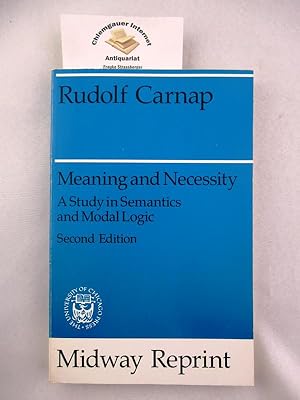
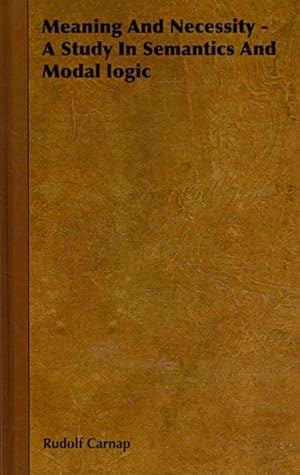


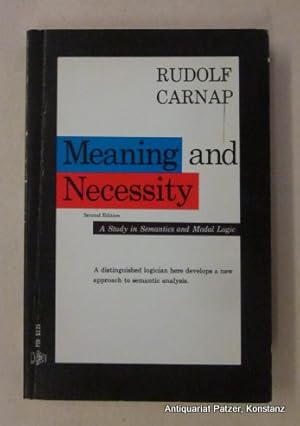
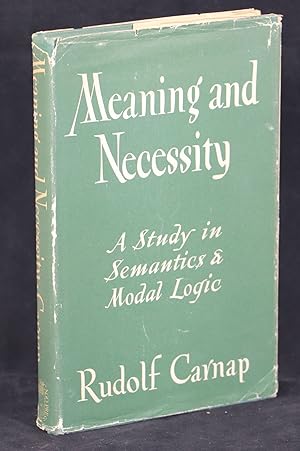
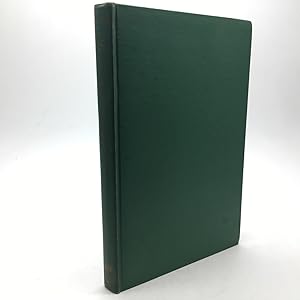
![Seller image for Meaning and Necessity. A Study in Semantics and Modal Logic. - [THE DEFINITIONS OF L-TRUE AND L-FALSE] for sale by Herman H. J. Lynge & Søn ILAB-ABF](https://pictures.abebooks.com/inventory/md/md1000801812.jpg)
![Seller image for Meaning and Necessity. A Study in Semantics and Modal Logic. - [QUINE'S COPY] for sale by Herman H. J. Lynge & Søn ILAB-ABF](https://pictures.abebooks.com/inventory/md/md2899684640.jpg)